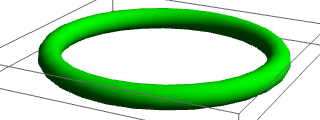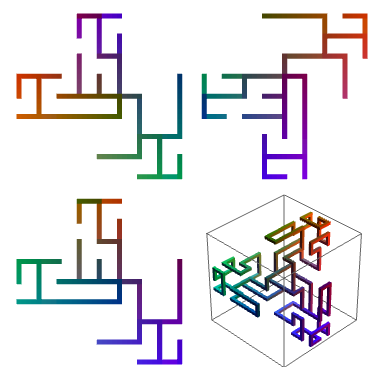Knot theory is a branch of topology which considers the different embeddings of a cycle into three-dimensional Euclidean space, R^3. The simplest type of knot is the unknot, which is just an ordinary circle (which can be ‘thickened’ to form a torus):
The second simplest knot, the trefoil knot, is obtained by doing a bog-standard knot in a piece of string and connecting the ends. It took a surprising amount of work by topologists to show that the trefoil knot and unknot are distinct. The usual way to show that two knots are not equivalent is to develop some kind of invariant which is preserved when you do elementary operations (known as Reidemeister moves) to a planar drawing of a knot.
A miraculous cycle
A few minutes ago I discovered that it’s possible to create a cycle (walk which visits no vertex more than once, except the start/end vertex) in Z^3 (three-dimensional integer lattice) with the following properties:
- The three projections parallel to the unit vectors are all trees;
- The cycle has threefold rotational symmetry;
- The cycle is a trefoil knot.
The cycle is a beautiful beast I’ve named the Treefoil, inhabiting a 9 × 9 × 9 box. You can see the three projections and a three-dimensional perspective view below:
Here is an isometric projection of an earlier version (11 × 11 × 11), which I since optimised to give the variant above.
For quite a while, a few people contemplated as to whether property 1 could be achieved. John Rickard, triple IMO gold medallist, was responsible for discovering the first example (the uniquely minimal solution). The problem featured on Professor Imre Leader’s More Introductory Problems sheet (question 9) and in the book Mathematical Mindbenders (by Peter Winkler), where a detailed history appears.
Note that every cycle in Z^3 satisfying property 1 yields a Borromean string with no balanced substring, and the converse is also true.
Hopf link
Much less beautiful (but almost as interesting) is a pair of interlinked cycles, such that the projections of the resulting Hopf link are all trees:
The Hopf link is so named because it features in the Hopf fibration (all great circles are linked in this manner). It’s not the only example of a pair of linked unknots; there are countably infinitely many, including the Whitehead link (the logo of the International Mathematical Olympiad).
By induction, you can create longer sets of linked cycles, homeomorphic to the Olympic rings. Whether you can subsequently connect the ends to form a link homeomorphic to the EGMO 2012 logo is another question entirely…






So, is it possible to have a trefoil embedded in a piecewise linear fashion in R^3 which has *four* different linear projections, all of them trees? I asked someone clever and he didn’t seem to think it was a daft question.
A weaker version of your question is to find a cycle embedded in R^3 such that four projections (parallel to a spanning set of vectors, to eliminate trivial solutions) are all trees. I suggest the vectors {(-1,1,1), (1,-1,1), (1,1,-1), (-1,-1,-1)}, and possibly the FCC lattice. If a cycle exists with this property, it can probably be used to build a trefoil knot in the same way I constructed the Treefoil.
By the way, Tim Large asked whether the symmetry group can be increased (D6 and V4 are possible symmetries for an ordinary trefoil) whilst having trees as projections. I have a proof that it’s impossible for a Treefoil to have a non-cyclic (dihedral) symmetry group, so my example does indeed have maximum symmetry.
I’ve since optimised it to 9 by 9 by 9 with a length of 132 (Rickard’s cycle, by comparison, is length 24). The number of complete spanning trees of an 8 by 8 grid graph is 1.26 * 10^26, which is far beyond the capabilities of an exhaustive computer search. It might be possible to exhaustively search all symmetric tree-projection cycles with length < 132, though.
Pingback: Recapping 2012 | Complex Projective 4-Space
Pingback: Further news | Complex Projective 4-Space
Hi. Simon Tatham pointed me at this posting. I would like to 3D-print your treefoil Z^3 cycle knot. I guess you must have it in some kind of machine-readable form that I could transform into a 3D model. Would you care to share it ? If I manage to print it I could post one to you.
Regards.
Pingback: Updates and errata | Complex Projective 4-Space